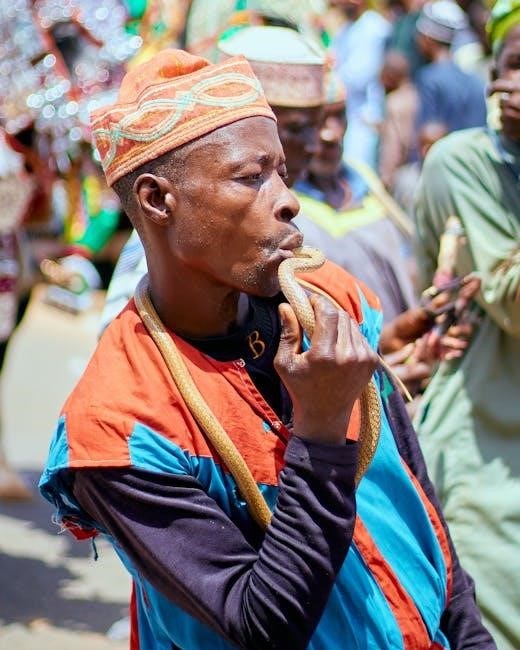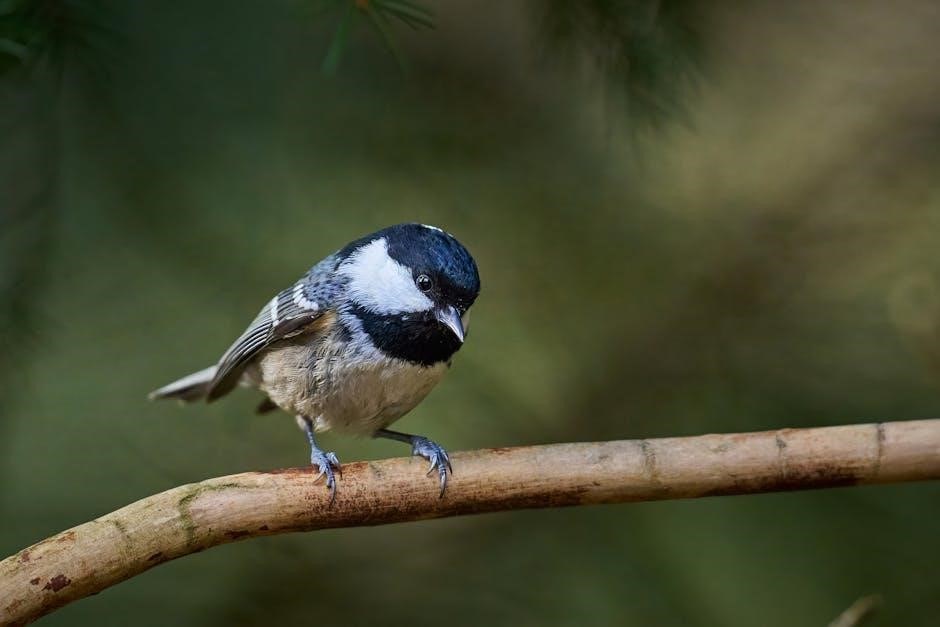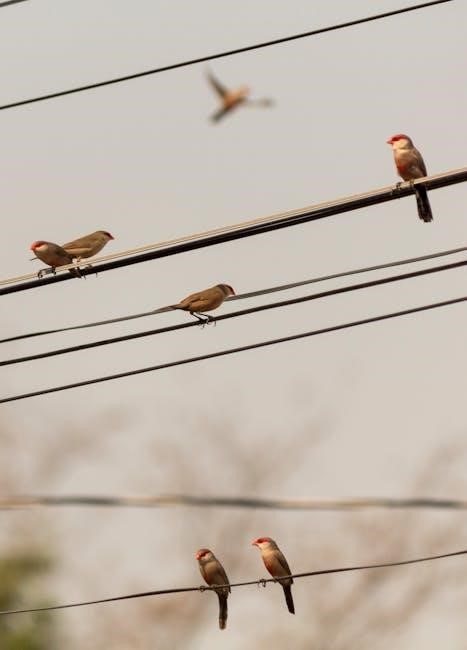Suzanne Collins’ The Ballad of Songbirds and Snakes offers a gripping prequel to The Hunger Games‚ exploring themes of fear‚ manipulation‚ and moral ambiguity in a dystopian world. The novel delves into the rise of Coriolanus Snow and the enigmatic Lucy Gray Baird‚ weaving a tale of power‚ rebellion‚ and survival. Through its intricate characters and symbolic use of songbirds and snakes‚ the story reveals the darker side of human nature and the cost of ambition. This introduction sets the stage for a journey into a world where control and deception reign supreme.

Overview of the Novel
The Ballad of Songbirds and Snakes by Suzanne Collins is a captivating prequel to The Hunger Games trilogy‚ set decades before the events of the original series. The novel introduces Coriolanus Snow‚ a young man from a once-prominent family‚ as he navigates the complexities of the Capitol’s power dynamics and his own ambitions. Against the backdrop of the 10th Hunger Games‚ Coriolanus crosses paths with Lucy Gray Baird‚ a charismatic tribute with a talent for music and manipulation. The story explores themes of fear‚ survival‚ and moral ambiguity‚ offering a deeper understanding of the origins of the Hunger Games and the rise of the oppressive Capitol. The novel intertwines political intrigue with personal struggles‚ setting the stage for the events that will shape Panem’s future.
Relevance of the Title: Songbirds and Snakes
The title The Ballad of Songbirds and Snakes symbolizes the contrasting themes of innocence and deception. Songbirds represent creativity‚ beauty‚ and freedom‚ embodied by Lucy Gray Baird‚ whose ballads captivate and inspire. Snakes‚ however‚ signify danger‚ manipulation‚ and corruption‚ reflecting Coriolanus Snow’s cunning and the Capitol’s oppressive nature. The title highlights the tension between these opposing forces‚ mirroring the moral ambiguity of the characters and the dystopian world they inhabit. By juxtaposing these symbols‚ Collins underscores the struggle between hope and despair‚ as well as the transformative power of fear and ambition. This duality sets the tone for the novel’s exploration of survival‚ rebellion‚ and the complexities of human nature.
Key Themes and Symbolism in the Book
The novel explores themes of fear‚ survival‚ and moral ambiguity‚ using songbirds and snakes as symbols of innocence and deception. These motifs highlight the struggle between hope and oppression‚ reflecting the darker aspects of human nature and the cost of ambition in a dystopian world.
The Capitol’s Control and Manipulation
The Capitol’s control is a pervasive theme‚ showcasing its manipulation through fear‚ propaganda‚ and the Hunger Games. The novel illustrates how the Capitol uses these tools to maintain power over the districts‚ suppressing rebellion and ensuring compliance. Characters like Coriolanus Snow and Dr. Gaul embody this manipulation‚ orchestrating events to further the Capitol’s agenda. The use of snakes as weapons and symbols of fear highlights the Capitol’s ruthless strategies to maintain dominance. This manipulation extends to the exploitation of fear‚ creating a culture of survival where morality is often compromised. The Capitol’s control is both subtle and overt‚ shaping the lives of its citizens and the fate of the nation.
The Role of Fear and Survival
Fear and survival are central to the narrative‚ driving characters’ actions and decisions. The Capitol’s manipulation fosters an atmosphere of dread‚ where fear becomes a tool of control. Coriolanus Snow’s rise is fueled by his fear of failure and desire to survive in a ruthless world. Lucy Gray Baird’s songs reflect her resilience‚ using music as a means to survive and inspire hope. The Hunger Games themselves embody the struggle for survival‚ where fear is both a motivator and a weapon. Characters must navigate moral dilemmas‚ often sacrificing their humanity to survive. This interplay of fear and survival underscores the novel’s exploration of human nature under oppressive regimes.
Moral Ambiguity in a Dystopian World
The novel explores moral ambiguity through its characters’ struggles in a dystopian society. Coriolanus Snow’s journey highlights the blurred lines between right and wrong‚ as he justifies ruthless actions for personal gain. Lucy Gray Baird‚ though kind-hearted‚ faces tough choices that challenge her moral compass. The Capitol’s oppressive regime forces individuals to question their ethics‚ often leading to morally questionable decisions. Even seemingly noble characters grapple with compromise‚ illustrating how survival in a corrupt system requires ethical flexibility. This moral complexity reflects the harsh realities of a world where power and survival often outweigh traditional notions of good and evil‚ leaving characters and readers to ponder the true cost of their choices.
Character Analysis
Coriolanus Snow evolves from a sympathetic figure to a cunning tyrant‚ driven by ambition and a need for power. Lucy Gray Baird‚ the enigmatic songbird‚ embodies both charm and hidden depth‚ using her talents to navigate the Capitol’s dangers. Dr. Gaul‚ the Capitol’s mastermind‚ exemplifies the oppressive regime’s manipulation and control. Each character’s complexity highlights the moral ambiguity and survival instincts in a ruthless world.
Coriolanus Snow: The Rise of a Tyrant
Coriolanus Snow’s transformation from a charming‚ manipulative young man to a ruthless tyrant is central to The Ballad of Songbirds and Snakes. His ambition and desire for power drive him to exploit others‚ including Lucy Gray Baird‚ using her talent for his own gain. Snow’s moral decay is evident as he justifies cruel actions‚ such as tampering with snakes‚ to ensure his survival and rise. His relationship with Dr. Gaul further solidifies his belief in the Capitol’s oppressive tactics. Despite his calculating nature‚ Snow’s vulnerability and fear of failure humanize him‚ making his descent into tyranny both unsettling and tragic. His choices ultimately shape the oppressive regime he later leads.
Lucy Gray Baird: The Enigmatic Songbird
Lucy Gray Baird captivates as the enigmatic “songbird” of The Ballad of Songbirds and Snakes‚ using her charm‚ wit‚ and musical talents to navigate the treacherous world of the Capitol. Her ballads serve as both a form of rebellion and a tool for survival‚ reflecting her resilience and creativity. Despite her tough exterior‚ Lucy Gray’s vulnerability and genuine emotions shine through‚ making her a complex and relatable character. Her interactions with Coriolanus Snow reveal a deep understanding of human nature‚ as she manipulates those around her to protect herself. Lucy Gray’s journey is a testament to the power of art and the enduring spirit of hope in a dystopian world.
Dr. Gaul: The Architect of Fear
Dr. Gaul emerges as a pivotal figure in The Ballad of Songbirds and Snakes‚ orchestrating fear and manipulation to maintain the Capitol’s grip on Panem. Her psychological prowess and scientific expertise make her a mastermind of oppression‚ leveraging tools like genetically engineered snakes to instill terror. Dr. Gaul’s influence extends beyond the Hunger Games‚ shaping Coriolanus Snow’s ruthless mindset and ambition. Her calculated demeanor and chilling detachment underscore her role as the architect of fear‚ driving the narrative’s darker themes; Through her actions‚ Collins highlights the dangers of unchecked power and the moral decay it fosters‚ making Dr. Gaul a formidable and unforgettable character in the story’s landscape.

Plot Exploration

The Ballad of Songbirds and Snakes unfolds in a dystopian Panem‚ where the Capitol’s oppressive regime is maintained through fear and manipulation. The story centers on Coriolanus Snow‚ a cunning young man rising through the ranks‚ and Lucy Gray Baird‚ a charismatic tribute whose ballads captivate the nation. The Hunger Games serve as a brutal tool of control‚ while genetically engineered snakes and strategic alliances amplify the tension. As the plot progresses‚ the stakes grow higher‚ revealing the dark underbelly of the Capitol’s power and the moral compromises required to survive in a world dominated by fear and deception.
The Hunger Games as a Tool of Oppression

In The Ballad of Songbirds and Snakes‚ the Hunger Games are depicted as a brutal mechanism of control‚ forcing tributes to fight to the death in a televised spectacle. This ritual serves to remind the districts of the Capitol’s dominance and crush any hint of rebellion. The Games are engineered to inspire fear‚ ensuring compliance through the threat of violence and humiliation. Coriolanus Snow‚ a rising Capitol figure‚ sees the Games as a means to consolidate power and maintain order. The use of genetically modified snakes and other mutations amplifies the terror‚ making the Games a powerful tool of psychological and physical oppression‚ reinforcing the Capitol’s grip on Panem.

The Use of Snakes as Weapons and Symbols
In The Ballad of Songbirds and Snakes‚ snakes are both literal weapons and symbolic representations of deception and danger. The Capitol employs genetically engineered snakes in the Hunger Games to instill fear and maintain control over the districts. These creatures are not only deadly but also serve as a visual reminder of the Capitol’s ruthless power. Coriolanus Snow’s manipulation of snakes to protect Lucy Gray highlights their dual role as tools of both destruction and subtle strategy. The snakes symbolize the covert threats and moral corruption that permeate the dystopian world‚ reflecting the darker aspects of human nature and the oppressive regime’s reliance on fear and manipulation to sustain its authority.

The Ballads as a Form of Rebellion
Lucy Gray Baird’s ballads in The Ballad of Songbirds and Snakes serve as a powerful form of rebellion against the Capitol’s oppression. Through her music‚ she conveys emotions and stories that resonate deeply with the districts‚ fostering a sense of unity and defiance. The ballads become a subtle yet effective means of challenging the Capitol’s control‚ as they spread messages of hope and resistance. Lucy Gray’s ability to weave her songs into the cultural fabric of Panem highlights the enduring power of art as a tool for rebellion‚ even in the face of overwhelming tyranny and surveillance. Her ballads ignite a spark of dissent‚ proving that words and melodies can be as potent as weapons in the struggle for freedom.

The Role of Ballads in the Story
The ballads in The Ballad of Songbirds and Snakes are central to the narrative‚ serving as a medium for storytelling‚ cultural expression‚ and subtle rebellion. They weave emotions‚ history‚ and defiance‚ influencing characters and plot dynamics while reflecting the deeper themes of the novel.
Lucy Gray’s Ballads and Their Impact
Lucy Gray Baird’s ballads are a powerful form of storytelling and rebellion in The Ballad of Songbirds and Snakes. Her songs‚ such as “The Valley” and “The Reaping‚” captivate audiences and subtly challenge the Capitol’s oppression. Through her music‚ Lucy Gray conveys emotions‚ histories‚ and hidden messages‚ fostering a sense of unity and defiance among the districts. Her ballads also deeply influence Coriolanus Snow‚ revealing the duality of her charm and the moral complexities of her actions. This artistic expression becomes a cultural cornerstone‚ symbolizing both hope and the struggle against tyranny‚ while showcasing Lucy Gray’s enigmatic and resilient character. Her songs leave a lasting impact on the story’s trajectory and themes.
The Cultural Significance of Music in the Novel
Music plays a pivotal role in The Ballad of Songbirds and Snakes‚ serving as a cultural anchor and a tool for both rebellion and manipulation. Lucy Gray’s ballads‚ rooted in district folklore‚ resonate deeply with audiences‚ fostering a sense of unity and shared identity. Her songs challenge the Capitol’s narratives‚ embedding subtle messages of defiance. Conversely‚ the Capitol weaponizes music to maintain control‚ using it to manipulate emotions and reinforce its authority. The interplay of melody and lyrics highlights the tension between authenticity and oppression‚ while also revealing the emotional depth of characters like Coriolanus Snow. Music becomes a mirror of the novel’s themes‚ reflecting the struggle between hope and tyranny.
Symbolism of Songbirds and Snakes
Songbirds symbolize innocence‚ hope‚ and creativity‚ while snakes represent deception and danger. Together‚ they embody the struggle between purity and corruption‚ reflecting Coriolanus Snow’s transformation from complexity to tyranny.
Contrasting Symbols: Innocence vs. Deception
The songbirds and snakes in the novel serve as powerful symbols‚ contrasting innocence with deception. Songbirds‚ like Lucy Gray’s melodies‚ represent purity‚ hope‚ and creativity‚ embodying the beauty of unchecked talent. Snakes‚ however‚ symbolize danger‚ manipulation‚ and deceit‚ reflecting the darker forces at play in Panem. Coriolanus Snow’s relationship with both symbols underscores his internal conflict‚ as he grapples with his own moral decay. While songbirds inspire and uplift‚ snakes remind us of the lurking threats and the destructive power of ambition. This duality highlights the novel’s exploration of human nature‚ where innocence and deception are constantly at odds‚ mirroring the broader societal struggles in Panem.

The Transformation of Coriolanus Snow
Coriolanus Snow’s transformation from a charismatic Academy student to a ruthless tyrant is central to the novel. His initial charm and ambition slowly give way to manipulation and deceit‚ driven by his desire for power. The snakes he controls symbolize his growing cunning and willingness to exploit others‚ while his interactions with Lucy Gray reveal a complex moral struggle. Snow’s transformation is marked by his increasing indifference to morality‚ as he embraces the Capitol’s oppressive tactics. By the end‚ he becomes the embodiment of the Capitol’s tyranny‚ leaving behind any trace of his former self. This evolution underscores the corrupting influence of power and ambition.

Reception and Impact
The Ballad of Songbirds and Snakes sparked intense debate among fans and critics‚ with some praising its deep dive into the Hunger Games universe‚ while others found it less compelling than the original trilogy. Readers were divided on Coriolanus Snow’s backstory‚ appreciating the complexity but questioning its necessity. The novel reignited discussions about the series’ themes and left fans reflecting on its place within the larger saga.
Reader Reactions to the Prequel
Readers had mixed reactions to The Ballad of Songbirds and Snakes‚ with some praising its deep dive into the Hunger Games universe and others finding it less compelling. Fans appreciated the complexity of Coriolanus Snow’s character‚ while some critics felt his rise to tyranny was overly detailed. The introduction of Lucy Gray Baird as a charismatic songbird resonated with many‚ though opinions were divided on her impact. The novel’s exploration of moral ambiguity and the origins of the Hunger Games sparked lively debates. While some readers found the pacing slow‚ others commended Collins for expanding the series’ lore. Overall‚ reactions highlighted the prequel’s ability to provoke thought and emotion‚ even as it divided opinions among fans of the original trilogy.
Comparisons with the Original Hunger Games Trilogy
The Ballad of Songbirds and Snakes offers a fresh yet familiar perspective‚ drawing comparisons to the original trilogy. While the core themes of oppression and rebellion remain‚ the prequel delves deeper into the Capitol’s motivations and the origins of the Hunger Games. Unlike Katniss’s fiery defiance‚ Coriolanus Snow’s ascent is marked by cunning and manipulation. The novel’s slower pacing and focus on political intrigue contrast with the action-driven narrative of the original trilogy. Fans noted that while the new characters are compelling‚ they lack the immediacy of Katniss and Peeta’s struggle. Overall‚ the prequel enriches the Hunger Games universe by exploring its complexities‚ though it stands apart in tone and style from the beloved original series.
The Ballad of Songbirds and Snakes masterfully explores the origins of Panem’s tyranny‚ offering a haunting prequel that delves into the complexities of power‚ morality‚ and survival. Through Coriolanus Snow’s transformation and Lucy Gray’s resilience‚ Suzanne Collins crafts a compelling narrative that expands the Hunger Games universe while standing on its own. The novel’s dark themes and intricate characters leave readers contemplating the true cost of ambition and control‚ cementing its place as a thought-provoking addition to the series.
The Legacy of “The Ballad of Songbirds and Snakes”
Suzanne Collins’ The Ballad of Songbirds and Snakes leaves a lasting impact on the Hunger Games universe‚ offering a profound exploration of its origins. This prequel delves into the rise of the Capitol’s tyranny‚ shedding light on the moral complexities that shaped Panem. By examining Coriolanus Snow’s transformation and Lucy Gray Baird’s resilience‚ the novel provides a deeper understanding of the series’ core themes. Its thought-provoking narrative challenges readers to reflect on the consequences of ambition‚ fear‚ and control. As a prequel‚ it not only enriches the existing trilogy but also stands as a compelling story in its own right‚ ensuring its legacy as a significant contribution to dystopian literature.
Final Thoughts on the Novel’s Themes and Characters
The Ballad of Songbirds and Snakes masterfully explores the complexities of human nature‚ ambition‚ and survival. Coriolanus Snow’s transformation from a privileged youth to a calculating tyrant underscores the dangers of unchecked power. Lucy Gray Baird‚ with her enigmatic presence and ballads‚ embodies the resilience of art and hope in a oppressive world. The novel’s themes of fear‚ manipulation‚ and moral ambiguity resonate deeply‚ leaving readers to ponder the ethical choices made by its characters. Collins’ vivid storytelling and well-crafted characters ensure that this prequel not only enriches the Hunger Games universe but also stands as a compelling exploration of the human condition‚ leaving a lasting impression on readers.
